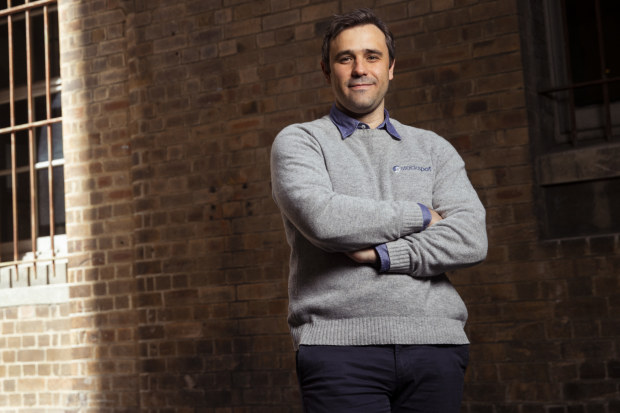The two things Millennials and Gen Z need to watch in their super

The best superannuation funds for younger people tend to have two things in common: total fees are kept to a maximum of 1 per cent and between 70 and 90 per cent of the money is invested in growth assets such as shares and property, according to robo-advice platform Stockspot’s chief executive Chris Brycki.
Stockspot analysis finds a high-fee fund charging 2 per cent per year would see a young person lose 27 per cent of the return in fees, while members with funds charging 1 per cent per annum would lose only 8 per cent.

Cost is critical, says Stockspot’s Chris Brycki. Dominic Lorrimer
By retirement, that means the high-fee member would have spent $334,825 in fees, while the low-fee member would have spent $108,565.
“Once you get the asset allocation right, the most critical thing for the long run is costs, because of the impact of compounding costs over time,” Brycki says.
Fees are charged as a percentage of funds under management. So if you have $100,000 in your fund, a 1 per cent fee will come to $1000.
You will see these fees on your annual statement or in the product disclosure statement. Typically, there will be an administration fee charged at either a fixed rate or a percentage, or a combination of both. You will usually also pay a membership fee.
Then, there is an investment management fee, usually charged as a percentage and some funds also charge a separate performance fee.

Watch the fees as your balance grows, says Shayne Sommer. James Brickwood
Unfortunately, says Brycki, there is no easy way to quickly find the total fee. But, generally speaking, once you have identified the different fees you may be paying, it’s a matter of multiplying your super balance by the total fee percentage to get a total expense ratio.
Shadforth Financial Group private wealth adviser Shayne Sommer says younger investors need to pay particular care if they’re in a super fund marketed as low-cost.
“As your balance grows, review the fees associated with your portfolio – ‘low-cost’ super funds are often ‘low cost’ while your balance is below $100,000. From there, there may be more competitive funds available,” she says.
Asset allocation
Asset allocation is slightly more complicated.
An allocation of between 70 and 90 per cent to growth assets (such as shares and property) means the majority of the money is invested in assets that will provide capital growth over time. The remaining 10 to 30 per cent should generally be given over to “defensive” assets such as cash and bonds, Brycki says.
Most balanced MySuper funds have about 70 per cent to 90 per cent allocated to growth assets.
Retail funds such as AMP and Colonial First State sort members into age groups and adjust exposure to growth assets. Members can dial up or dial down risk if they want to be more actively involved.
The argument is that the portfolios of younger investors can be loaded with riskier, high-growth assets because they can ride out periods of volatility.
Although shares and real estate are traditional growth assets, super funds have progressively invested more in other asset classes also classified as growth – including unlisted infrastructure and property, private equity and venture capital.
Australian Super, for example, partly owns Sydney Airport and Hostplus invests in early-stage companies in the hope they will become the tech unicorns of the future.
Hostplus chief investment officer Sam Sicilia says the fund’s younger membership base – and the continual flow of new, younger members coming from the hospitality industry – means it can afford to invest more heavily in unlisted growth assets because they won’t need the money for decades.
Hostplus has 41 per cent of its money in unlisted assets, including property, venture capital and private equity.
“When you have much more cash coming in than is leaving, that [gives you] the firepower to not just do the next investment, but every investment that you want to do,” Sicilia says.
“You couldn’t tolerate illiquidity if you had a lot of members switching or leaving your fund and going somewhere else – then you’d only be in listed equities and listed bonds.”
Conversely, a fund with an ageing demographic needs to hold many liquid assets so it can pay people who want to cash out or draw a retirement income.
”You can’t avoid a dip in the market – it affects everyone.
“But if you have a younger demographic, you can withstand those dips because they have a lot more time to recover,” says Sicilia.
“In other words, if I was the CIO of a fund with a much older demographic, I couldn’t do what I do here.”
Brycki agrees with Sicilia in terms of exposure to growth assets, but he relies on listed growth assets, and he says there are concerns about the way other funds valuate their unlisted assets.
The super industry has been under pressure to increase the frequency of funds’ unlisted asset valuations to at least once a quarter, and more often during periods of volatility, amid concerns fund performance is being artificially boosted by delayed valuations.
Whole of wealth approach
Viridian Advisory financial adviser Lakshan Weerasinghe says investors should keep investments outside super in mind.
“If you have a large Australian share portfolio in your personal name, and you then also include a significant weighting to Australian shares in your superannuation, are you overexposed to this asset class?” Weerasinghe asks.
“While these are two separate structures and investments, they do form a part of your overall investible assets, so consideration must be given to this.
“Most superannuation fund websites will contain information on the asset allocation of their investment options. However, the level of transparency provided around this will depend on the fund you are researching. ”
Introducing your Newsfeed
Follow the topics, people and companies that matter to you.
Find out moreRead More
Latest In Superannuation & SMSFs
Fetching latest articles